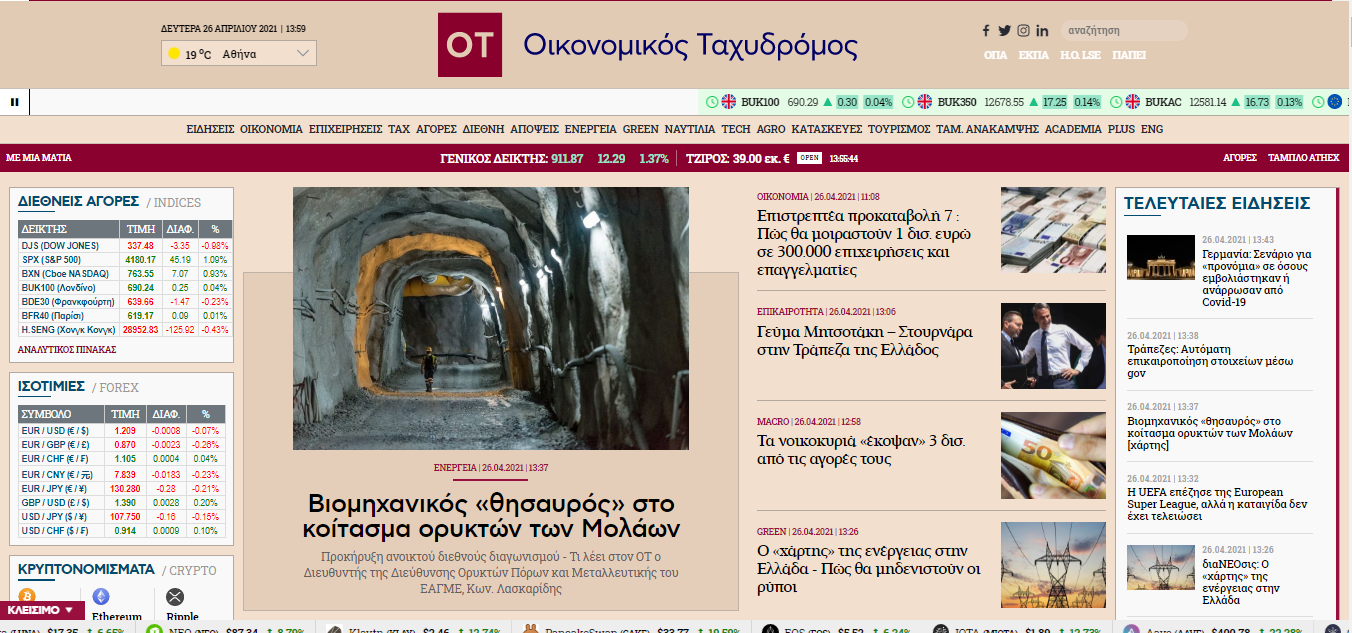Interview of Dr. Konstantinos Laskaridis, Director of Mineral Resources and Mining at the HSGME, for Oikonomikos Tachydromos.
A deposit containing minerals of critical importance for several industrial sectors — and even for the rapidly growing field of energy storage systems (next-generation batteries) — lies hidden near Molaoi, Laconia.
Last week, the Ministry of Environment and Energy announced the utilization of part (Section A) of the Molaoi Public Mining Area through an open international tender consisting of two phases. The first concerns the expression of interest, and the second involves the submission of binding offers for leasing the state’s mining rights over an area of 9.8 square kilometers.
According to information from “Oikonomikos Tachydromos,” the ministry launched the tender — with the first phase deadline set for May 21 — following unofficial interest expressed by Australian investors. They reportedly aim to explore and exploit this polymetallic deposit, notable for its concentrations of zinc, lead, cadmium, and silver.
The history of the deposit and the mine dates back to 1978, when the former IGME (now HSGME) began its first surveys. The initial attempt to exploit this mineral wealth was made in 1985 by METVA (Metallurgical Industries of the Aegean S.A.), which, however, abandoned its efforts in 1990 due to low metal prices. At the time, IGME researchers estimated reserves of 3.3 million tons — a significant indication of a commercially exploitable deposit.
“O.T.” spoke with Dr. Konstantinos Laskaridis, Director of the Directorate of Mineral Resources and Mining at the HSGME, about the mine’s history, the significance of the deposit, and the potential uses of its minerals.
The interview is as follows:
Q: Dr. Laskaridis, when was the Molaoi deposit discovered, and which minerals does it contain?
Exploration by IGME (now HSGME) began in 1978, involving mineral mapping at scales of 1:20,000, 1:5,000, and 1:1,000, along with geochemical surveys (Section A of the attached map). The investigations continued with geophysical surveys, mineralogical laboratory studies of the ore concentrations, and over 100 drill holes, leading to the discovery of a massive sulfide deposit rich in Zn (zinc), Ag (silver), and Pb (lead) — the well-known Molaoi deposit of Laconia.
Based on these research results, the deposit was determined to:
Belong to the group of stratiform volcanogenic massive sulfide deposits, with main ore minerals being sphalerite, pyrite, and galena, and notable concentrations of cadmium and silver. It is a polymetallic Kuroko-type deposit containing Zn–Pb–Ag–Cd (Zinc–Lead–Silver–Cadmium). In 1985, an IGME working group prepared a preliminary techno-economic study estimating in situ reserves at 3.3 million tons.
Q: Has it been previously exploited by another investor?
Section A of the area — since the others were never leased — was granted in 1985 to METVA (Metallurgical Industries of the Aegean S.A.), which abandoned it in 1990. A subsequent international tender for exploration and exploitation rights was awarded to DECADE INTERNATIONAL DEVELOPMENT LTD, but the lease contract was never finalized due to the company’s inaction.
Q: How are its minerals used in industry or other sectors?
These are minerals used across many industries: in manufacturing (metal components, PVC and plastic pipes, lead sheets, ammunition, enamels, paints), construction, and alloy production (for the automotive sector, electrical components, musical instruments, and anti-corrosion marine applications). They also find uses in everyday products (cosmetics, sunscreens, shampoos), medicine and healthcare, jewelry, as well as in environmental and agricultural applications.
Q: The EU has a growing demand for raw materials used in battery manufacturing as part of its renewable energy and energy storage goals. Can this deposit and its minerals contribute to meeting these needs?
Yes, they can serve as substitutes for rarer minerals in next-generation batteries capable of storing energy from photovoltaic parks.
Q: Studies suggest that the broader region (around Molaoi) is rich in valuable mineral deposits. What is HSGME’s view?
The area’s development potential should be based on a new techno-economic reassessment of the existing mining potential at Molaoi, along with exploration for exploitable concentrations of In, Ge, and Ga (Indium, Germanium, Gallium). These elements belong to the group of Critical Raw Materials and are considered essential and strategic for European industry.


